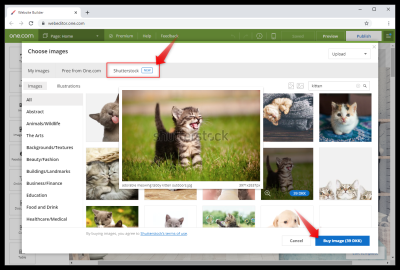Ever wondered if those everyday moments you capture on your phone could turn into a source of income? Shutterstock is a fantastic platform that allows photographers and casual shooters alike to monetize their photos. Whether it’s a beautiful sunset, a cozy coffee shop scene, or a simple close-up of a plant, your everyday photos can find a home and earn you money. The best part? You don’t need to be a professional photographer to get started. With a little guidance and some good photos, you could be on your way to earning passive income while doing what you love—taking pictures of the world around you.
Understanding Shutterstock’s Contributor Program

Shutterstock‘s Contributor Program is the gateway for anyone looking to sell their photos online. It’s designed to be user-friendly, making it accessible whether you’re an experienced photographer or just someone who loves snapping pictures with their phone. Here’s a quick rundown of how it works:
- Sign Up: Create a free account as a contributor on Shutterstock’s website. You’ll need to provide some basic info and agree to their terms.
- Upload Your Photos: Once registered, you can start uploading your images. It’s best to upload high-quality, well-lit photos that are clear and focused.
- Tag and Describe: Add relevant keywords and descriptions to your photos. This step is crucial because it helps buyers find your images when they search.
- Get Approved: Shutterstock reviews your submissions to ensure they meet quality standards. Don’t worry—most good photos get approved quickly.
- Earn Royalties: Every time someone downloads one of your images, you earn a royalty. The amount varies depending on your contributor level and the type of license purchased.
One of the great things about Shutterstock is its large community of buyers, which means your photos have a good chance of being seen and downloaded. Plus, the platform offers helpful resources and tips to improve your submissions. Whether you’re uploading casual snaps or professional-looking shots, understanding how the contributor program works is key to turning your collection of everyday photos into a steady income stream.
What Types of Photos Are in Demand on Shutterstock
So, you’re wondering what kinds of photos actually sell well on Shutterstock? Well, the truth is, certain themes and styles tend to be more popular because they match what buyers are looking for. Shutterstock is used by a wide range of clients—from marketing agencies and website owners to bloggers and app developers—so there’s a big demand for versatile, high-quality images. Here are some of the most in-demand categories:
- People and Lifestyle: Candid shots of everyday life, diverse groups, families, professionals working, or people enjoying hobbies. Authenticity is key here—buyers love natural, relatable moments.
- Business and Technology: Photos depicting work environments, remote work setups, gadgets, and modern tech. These are great for corporate websites and presentations.
- Health and Wellness: Yoga, fitness, healthy eating, mental wellness—all these themes are trending as health consciousness grows.
- Nature and Outdoors: Scenic landscapes, parks, outdoor activities, and environmental themes are always popular—especially in times when people seek escape or inspiration.
- Food and Drink: Delicious, well-styled images of meals, drinks, and cooking scenes tend to perform well, especially if they look fresh and inviting.
- Travel: Photos of landmarks, hidden gems, or even everyday scenes from different destinations help fulfill the demand for travel content.
Remember, authenticity and diversity are huge here. Buyers often search for images that feel real and inclusive, so don’t shy away from capturing different ages, ethnicities, and lifestyles. The more versatile your portfolio, the better your chances of making sales.
Tips for Taking High-Quality Everyday Photos
Now that you know what kind of photos are in demand, let’s talk about how to actually capture those perfect shots. You don’t need a fancy camera—your smartphone can do the job if you follow these simple tips:
- Focus on Lighting — Natural light is your best friend. Shoot during the golden hours—early morning or late afternoon—when the light is soft and warm. Avoid harsh midday sun unless you want strong shadows.
- Keep It Authentic — Candid, unstaged moments resonate more with buyers. Capture people genuinely engaged in activities or expressions rather than overly posed shots.
- Pay Attention to Composition — Use the rule of thirds: imagine dividing your frame into nine equal parts and place key elements along these lines or at intersections. Keep your shots clean and uncluttered.
- Focus on Sharpness and Clarity — Make sure your images are sharp and well-focused. Avoid blurry shots unless it’s an artistic choice. Clean your lens regularly to prevent smudges or dust spots.
- Use Simple Backgrounds — Clear, uncluttered backgrounds help the subject stand out and look more professional. Look for backgrounds that add context without distracting from the main focus.
- Capture Different Perspectives — Experiment with different angles and distances. Get close-ups, wide shots, and even some overhead angles to add variety to your portfolio.
- Edit Thoughtfully — Basic editing can enhance your photos. Adjust brightness, contrast, and saturation to make your images pop, but avoid over-editing. Keep things looking natural.
Remember, practice makes perfect. Keep experimenting, review your shots critically, and don’t be afraid to take lots of photos. The more you shoot, the better your chances of capturing that one perfect image that sells on Shutterstock!
Optimizing Your Photos for Better Visibility and Sales
Once you’ve uploaded your photos to Shutterstock, the next step is making sure they get noticed. After all, even the most stunning photos won’t sell if no one sees them! Optimization is key to increasing your visibility and boosting your sales. The good news? It’s pretty straightforward once you know what to focus on.
First off, pay close attention to your keywords. Think of keywords as the tags that help your photos show up when someone searches for a specific term. Use relevant, specific, and varied keywords—don’t just stick to obvious ones like “photo” or “nature.” Instead, include details like the mood, colors, location, and subject. For example, instead of just “dog,” try “happy golden retriever playing in park.”
Next, craft compelling titles and descriptions. Your title should be clear and descriptive, highlighting the main subject. Descriptions are your chance to add context and include additional keywords naturally. Remember, the goal is to make it easy for customers to find your image when they search for related terms.
Another tip is to pay attention to the quality and composition of your photos. Clear, well-lit images with good composition tend to perform better. Shutterstock prefers professional-looking photos that are sharp, properly exposed, and free of noise or distractions. Think about the story your photo tells and whether it fits common themes or trends in the marketplace.
Staying on top of current trends can also help your photos stand out. For instance, if minimalism or vibrant colors are trending, consider capturing images that fit these themes. Browse Shutterstock’s trending collections or popular searches to get inspiration.
| Optimization Tip | Description |
|---|---|
| Use Relevant Keywords | Include specific tags that describe your photo in detail to improve search visibility. |
| Write Clear Titles & Descriptions | Help buyers understand your image and include keywords naturally in your descriptions. |
| Ensure High Quality | Upload sharp, well-lit, and professionally composed images that meet Shutterstock standards. |
| Follow Trends | Capture images that align with current market trends to increase chances of sales. |
Remember, optimization isn’t a one-time task. Keep reviewing your images’ performance, tweak keywords, and update descriptions if needed. Over time, you’ll learn what works best for your photos, and your sales will start to grow!
Uploading and Managing Your Photos on Shutterstock
Uploading your photos to Shutterstock is pretty straightforward, but managing your portfolio effectively is what will really make a difference in your earning potential. Let’s walk through both processes so you can stay organized and maximize your sales.
First, to upload photos, log into your contributor account and click on the “Upload” button. Shutterstock allows batch uploads, so you can select multiple images at once, which saves a lot of time. Before uploading, make sure your photos meet Shutterstock’s technical requirements: they should be high-resolution, in JPEG format, and free of watermarks or logos. Also, ensure they are properly edited—good lighting, sharp focus, and correct exposure go a long way.
Once uploaded, you’ll be prompted to add metadata: titles, descriptions, and keywords. As we discussed earlier, this step is crucial for visibility, so take your time to fill these out thoughtfully. You can also assign images to relevant categories and collections to keep things organized.
Managing your portfolio is just as important as uploading. Regularly review your images’ performance metrics—such as views, downloads, and sales. Shutterstock provides analytics tools that help you see which photos are popular and which aren’t performing as well. Use this data to inform your future shoots and uploads.
Keep your portfolio fresh by consistently adding new images. This not only increases your chances of sales but also shows Shutterstock that you’re an active contributor, which can boost your visibility in search results. Additionally, periodically revisit older uploads. If some photos aren’t performing, consider updating their keywords or replacing them with improved versions.
Organizing your images into collections or folders makes it easier to manage large portfolios. For example, create collections based on themes—”Business,” “Nature,” “Food”—or by project. This way, when a client requests a specific type of image, you can quickly find and promote relevant photos.
Finally, stay informed about Shutterstock’s guidelines and updates. Contributing quality images that adhere to their standards ensures your account remains in good standing and your images stay available for licensing.
In summary, uploading is just the start. Active management, staying organized, and analyzing your performance will help you make the most of your everyday photos and turn your hobby into a steady income stream.
Promoting Your Portfolio to Increase Sales
Once you’ve uploaded a collection of great photos to Shutterstock, the next step is making sure people actually see and buy your work. Promoting your portfolio might sound a bit intimidating at first, but with a few simple strategies, you can boost your visibility and increase sales.
First off, share your portfolio on your social media channels. Platforms like Instagram, Twitter, Facebook, and LinkedIn are fantastic for showcasing your images. Create posts that highlight your best shots, tell the story behind them, or show how they can be used in real-life projects. Use relevant hashtags to reach a broader audience—think photography, stockphotos, or niche-specific tags like businessphotos or foodphotography.
Another great tip is to engage with online communities and forums related to photography and stock images. Websites like Reddit, photography Facebook groups, or specialized forums allow you to connect with potential buyers or other contributors. Share your work, ask for feedback, and offer helpful advice. Building relationships here can lead to referrals or direct commissions.
Don’t forget about SEO (Search Engine Optimization). When you upload your images, make sure your titles, descriptions, and keywords are clear, relevant, and specific. Think about what someone looking for your type of photo would search for. For example, instead of just “flower,” use “vibrant sunflower field during summer.” This helps your images show up in Shutterstock’s search results and even in Google image searches.
| Promotion Tip | Why It Helps |
|---|---|
| Share on social media | Increases exposure and drives traffic to your portfolio |
| Participate in online communities | Builds relationships and gets your work seen by niche audiences |
| Optimize titles and keywords | Boosts your images in search results, leading to more downloads |
| Create a personal website or blog | Shows off your best work and provides a central hub for your portfolio |
Consistency is key. Regularly updating your portfolio with fresh images and actively promoting them keeps your work top of mind for buyers. Remember, patience and persistence pay off. Over time, your efforts will translate into more downloads and, ultimately, more income from your everyday photos.
Common Mistakes to Avoid as a Shutterstock Contributor
While making money on Shutterstock can be rewarding, there are some common pitfalls that new contributors often fall into. Being aware of these mistakes can save you time, effort, and frustration, and help you build a successful portfolio.
Mistake 1: Uploadting Poor Quality or Outdated Photos. Remember, Shutterstock has high standards. Uploading blurry, poorly lit, or over-edited images can lead to rejection or low sales. Always ensure your photos are sharp, well-exposed, and relevant. Keep your portfolio fresh by adding new, high-quality images regularly.
Mistake 2: Ignoring Keyword Optimization. If you don’t use accurate and relevant keywords, your images won’t appear in search results. Avoid keyword stuffing or using vague tags like “beautiful” or “nice.” Instead, think about what your potential buyers might search for and use specific terms, including relevant themes, objects, colors, and styles.
Mistake 3: Overloading Your Portfolio with Similar Shots. While it’s good to have a diverse collection, uploading too many similar images can dilute your portfolio. Focus on variety—different angles, compositions, and concepts—to appeal to a broader audience.
Mistake 4: Not Reading Shutterstock’s Guidelines. Each platform has rules about model releases, property releases, and content restrictions. Ignoring these can lead to rejection or even account suspension. Always review Shutterstock’s contributor guidelines carefully before uploading.
Mistake 5: Forgetting to Promote Your Work. Relying solely on Shutterstock’s internal search isn’t enough. Promote your portfolio actively on social media, your website, or through email newsletters. The more visibility your images get, the higher your chances of making sales.
Mistake 6: Giving Up Too Quickly. Success on Shutterstock doesn’t happen overnight. If you don’t see immediate results, don’t get discouraged. Keep uploading, optimizing, and promoting. Over time, your consistent effort will build a steady stream of income.
By avoiding these common mistakes and focusing on quality, relevance, and promotion, you’ll be well on your way to turning your everyday photos into a reliable income stream on Shutterstock. The key is to stay patient, keep learning, and continue improving your craft every day.
Additional Tips for Success in Selling Everyday Photos
So, you’re ready to take your everyday photos to the next level and start earning on Shutterstock. That’s fantastic! While snapping good photos is the first step, there are a few extra tips that can help you stand out and boost your sales.
1. Pay Attention to Composition and Lighting
Even casual photos can look professional if you focus on composition and lighting. Use natural light whenever possible—early mornings and late afternoons often provide the best, soft light. Keep your shots clean and uncluttered, and try to follow basic rules like the rule of thirds to make your images more engaging.
2. Focus on Clear, Relevant Subjects
Make sure your subject is easily identifiable and relevant to common stock photo searches. For example, instead of a blurry shot of a coffee mug, try a well-lit, focused image of a steaming cup on a cozy table. Clear, relevant images tend to perform better and attract more buyers.
3. Use Keywords Effectively
Keywords are your best friends when it comes to discoverability. Think about what someone might type to find your photo. Be specific and include related words. For example, if you have a photo of a person working on a laptop in a coffee shop, keywords like “remote work,” “coffee shop,” “freelancer,” and “technology” can help your photo appear in more searches.
4. Keep an Eye on Trends
Stock photo trends change over time, so stay updated with what’s popular. Check out Shutterstock’s trending images or browse similar photos to see what’s in demand. Incorporating trending themes or styles can give your photos a better chance of selling.
5. Diversify Your Portfolio
Don’t put all your eggs in one basket. Upload a variety of photos—different subjects, settings, and styles. This increases your chances of making sales across different categories and appeals to a broader audience.
6. Be Patient and Consistent
Selling stock photos is often a game of patience. Keep uploading regularly, and don’t get discouraged if some photos don’t sell immediately. Over time, your portfolio will grow, and your images will start gaining more visibility.
Remember, success doesn’t usually happen overnight, but with consistent effort and attention to detail, your everyday photos can become a steady source of income on Shutterstock.
Conclusion and Final Thoughts on Making Money with Shutterstock Photos
Getting started with selling your everyday photos on Shutterstock can be both exciting and rewarding. The key is to remember that you don’t need professional-grade equipment or studio setups—your smartphone and a good eye are often enough to create appealing images that people want to buy.
By focusing on capturing authentic, relatable moments, paying attention to composition and lighting, and effectively using keywords, you set yourself up for success. Keep experimenting with different subjects, stay updated on trends, and upload consistently to build a diverse and attractive portfolio.
Most importantly, be patient. Stock photography is a long-term game, and the more you upload, the better your chances of making consistent sales. Over time, your collection of everyday photos can become a reliable income stream, all while doing something you enjoy—taking photos of the world around you.
So grab your camera or phone, start snapping those candid shots, and watch as your everyday moments turn into earning opportunities. Happy shooting and selling!


